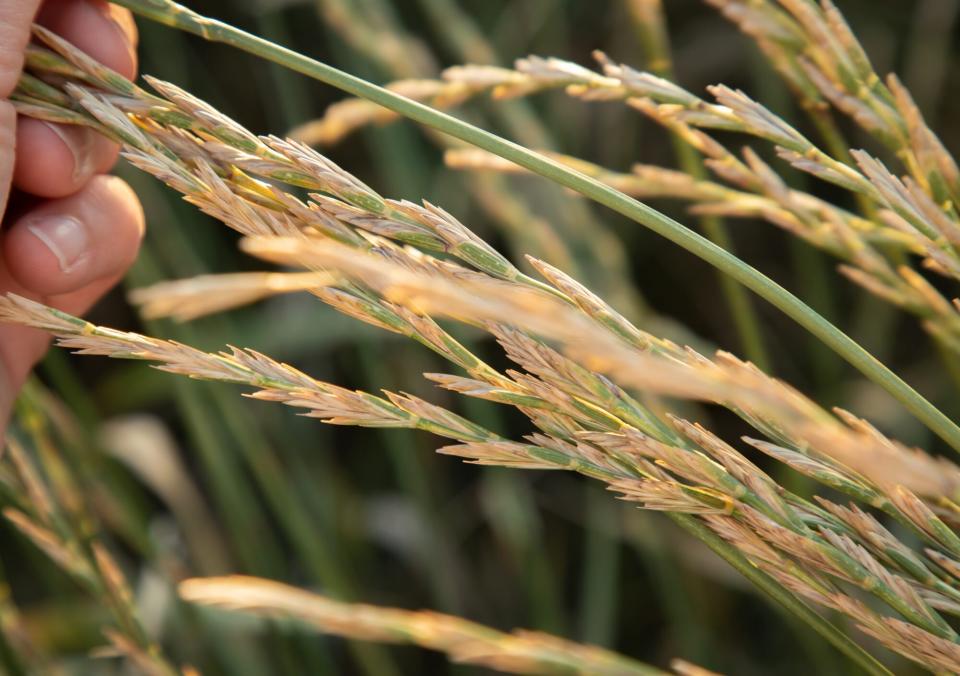Your Guide to Kernza: A Super Grain That's Good for You and the Planet
As our world continues to hurtle toward a more uncertain future thanks to climate change, farmers and consumers keep searching for more sustainable food options. One product showing some hope? A perennial grain called Kernza. But what is it exactly, why is it so important to climate, what are its health benefits, and where can you find it? We're here to give you the lowdown on Kernza, sharing everything you need to know about the super-grain.
Related: Over 5,000 Foods Are at Risk of Going Extinct—Here's Why That Matters
What Is Kernza?
Kernza is a whole grain that's harvested from intermediate wheatgrass. It's related to annual wheat and has previously been grown throughout the U.S. as food for livestock. In 2008, it began to be domesticated by a nonprofit called the Land Institute as a grain suitable for human consumption. By spring of 2021, there were 3,500 acres of Kernza in production.

Courtesy of Kernza
Why Is Kernza Good for the Environment?
Kernza is extremely sustainable. It can be grown as a "multi-functional" crop and is a perennial grain, unlike wheat, which is an annual and needs to be replanted each year—this strips the earth each time it's grown and harvested. Perennial grains free farmers from the costly operational expenses of tillage (which is also bad for the climate as it releases carbon into the air) and planting so often. Moreover, perennial grains are known to protect soil from erosion and generally improve soil structure thanks to their deep roots—Kernza's can be more than 10 feet long. Those long roots also draw down harmful carbon (otherwise known as greenhouse gas) from the air and trap it underground (called carbon sequestration), directly mitigating climate change. Perennial grains also increase ecosystem nutrient retention, water infiltration, help with crop diversity, and ensure food and water security over the long term.
Is Kernza Good for You?
Kernza is high in protein and antioxidants, and it has eight times the amount of insoluble fiber as wheat, making it an extremely healthy option. To be precise, it has 18 grams of fiber and 19.2 grams of protein per 100 grams (to compare, wheat has 10.8 grams of fiber and 9.2 grams of protein). It's not gluten-free, but it has less gluten than wheat.
Where Can You Find Kernza and What Does It Taste Like?
Kernza has a sweet, nutty flavor and can be used as a whole grain, ground into flour, malted, or directly added to beer and whiskey. Kernza isn't everywhere yet; you may have to search a bit to find it (and it's more expensive than traditional flour). Right now, it's available at certain stores and online, usually as ground flour ($17.49, amazon.com) or the whole grain ($9.99, amazon.com). Perennial Pantry also has Kernza flour ($11.99, perennialpantry.com) and a pancake and waffle mix with Kernza ($6.99, perennialpantry.com).
Columbia County Bread sells flatbread crisps made from Kernza ($32.50 for a five pack, columbiacountybread.com). Cascadian Farm had a limited0edition breakfast cereal made from Kernza at Whole Foods, and Patagonia Provisions recently released Long Root IPA beer in partnership with Hopworks Urban Brewery in Portland, Oregon, which uses Kernza. It's actually their third Kernza beer; after launching Long Root Pale Ale in 2016 followed by Long Root Wit, which are all available at certain stores. And the brand just launched Patagonia Provisions Organic Kernza Fusilli, the first commercially available Kernza pasta. It's sold in select grocery stores.

